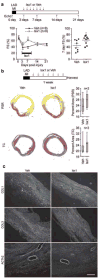Targeting native adult heart progenitors with cardiogenic small molecules
- PMID: 22413910
- PMCID: PMC3376223
- DOI: 10.1021/cb200525q
Targeting native adult heart progenitors with cardiogenic small molecules
Abstract
Targeting native progenitors with small molecule pharmaceuticals that direct cell fate decisions is an attractive approach for regenerative medicine. Here, we show that 3,5-disubstituted isoxazoles (Isx), stem cell-modulator small molecules originally recovered in a P19 embryonal carcinoma cell-based screen, directed cardiac muscle gene expression in vivo in target tissues of adult transgenic reporter mice. Isx also stimulated adult mouse myocardial cell cycle activity. Narrowing our focus onto one target cardiac-resident progenitor population, Isx directed muscle transcriptional programs in vivo in multipotent Notch-activated epicardium-derived cells (NECs), generating Notch-activated adult cardiomyocyte-like precursors. Myocardial infarction (MI) preemptively differentiated NECs toward fibroblast lineages, overriding Isx's cardiogenic influence in this cell population. Isx dysregulated gene expression in vivo in Notch-activated repair fibroblasts, driving distinctive (pro-angiogenesis) gene programs, but failed to mitigate fibrosis or avert ventricular functional decline after MI. In NECs in vitro, Isx directed partial muscle differentiation, which included biosynthesis and assembly of sarcomeric α-actinin premyofibrils, beaded structures pathognomonic of early developing cardiomyocytes. Thus, although Isx small molecules have promising in vivo efficacy at the level of cardiac muscle gene expression in native multipotent progenitors and are first in class in this regard, a greater understanding of the dynamic interplay between fibrosis and cardiogenic small molecule signals will be required to pharmacologically enable regenerative repair of the heart.
Figures





References
-
- Tsao L, Gibson CM. Heart failure: an epidemic of the 21st century. Crit Pathw Cardiol. 2004;3:194–204. - PubMed
-
- Daley GQ, Scadden DT. Prospects for stem cell-based therapy. Cell. 2008;132:544–548. - PubMed
-
- Zhou B, Honor LB, He H, Ma Q, Oh JH, Butterfield C, Lin RZ, Melero-Martin JM, Dolmatova E, Duffy HS, Gise A, Zhou P, Hu YW, Wang G, Zhang B, Wang L, Hall JL, Moses MA, McGowan FX, Pu WT. Adult mouse epicardium modulates myocardial injury by secreting paracrine factors. J Clin Invest. 121:1894–1904. - PMC - PubMed
-
- Grayson P, Mendlein J, Thies S, Yingling J. Stem cell modulators (SCMs): a small molecule and biologic approach to stem cell therapeutics. Drug Discovery Today: Therapeutic Strategies. 2009;6:141–145.
-
- Adams GB, Martin RP, Alley IR, Chabner KT, Cohen KS, Calvi LM, Kronenberg HM, Scadden DT. Therapeutic targeting of a stem cell niche. Nature biotechnology. 2007;25:238–243. - PubMed
Publication types
MeSH terms
Substances
Grants and funding
LinkOut - more resources
Full Text Sources
Other Literature Sources
Medical

